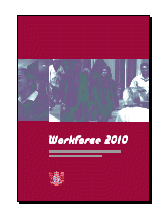

- A Debate We Need: Review
- The report highlights the following significant trends:
— The years to 2010 will involve similar influences to the last ten years with globalisation, technology, demographic, social, workplace and workforce trends continuing.
— Globalisation has changed the face of New Zealand, and will continue to do so — impacting on most areas of life.
— New Zealand has become increasingly integrated into the world economy, and domestic growth (both social and economic) increasingly depends on social and economic growth elsewhere.
— There are widely divergent forecasts about the future of "work". Some predict that work in its current form will disappear, others predict a change in its nature consistent with communication and technological change. Workforce 2010 suggests that, in the absence of major global events, change will occur over time rather than as a radical change.
— There is increasing risk that there will be "pockets of New Zealanders" who, for many reasons, are unable to directly share in the wealth generated in the labour market. Workforce 2010 warns: "Inequality may increase". - The report says that employment growth remains highly reliant on sustainable
economic growth. It sees future employment opportunities in New Zealand as likely to include:
— A continuing shift towards employment in the tertiary sector, in particular travel, leisure and entertainment, financial services, technology and health care.
— More upper white collar workers will be required, including people with high levels of literacy and numeracy. This may create a risk if New Zealand's capacity in these areas does not meet the required standards.
— More service sector employment, with increasing opportunities developing to cater for the changing age structure of New Zealand.
— Increasing demand by some employers and some workers for non-standard work patterns (part time /seasonal / voluntary work).
— Increased competition for skilled migrants as the age structure of other countries changes. This includes increased opportunities for New Zealanders abroad and heightened competition for highly skilled New Zealanders. - The report says that these opportunities will also involve significant risks and challenges:
— The continued opening up of world trade, migration and information flows may lead to some domestic opportunities declining if greater returns can be gained offshore.
— Differing growth paths of regions or locations could provide for an insufficient level of opportunities for people in some regions. There is the risk of an increasing disparity between the main urban centres and non-urban centres.
— A changing demographic profile will likely see a rise in the number of opportunities for services relating to our ageing population.
— Productivity gains in non-service sectors of the economy may not be sufficient to support the increased demand for services.
— Technology changes are likely to continue to reduce the significance of New Zealand's innate handicaps such as size and isolation.
— Increased scarcity of appropriate labour could encourage businesses to discriminate less against older workers, and may increase re-training opportunities for older workers. - Workforce 2010 warns that while "workforce outcomes" over the coming decade might
be fine, there is a risk that preparations for challenges beyond 2010 "...will be insufficient".
The report concludes that this coming decade will provide New Zealand with an opportunity to
build a strong base for the years 2010 onwards, a period in which demographic changes are likely to
be even more pronounced.

Workforce 2010 — a document to inform public debate on the future of the labour market in New Zealand
Published 2000 by the New Zealand Government
ISBN 0-477-03644-9
Copies available from Labour Market Policy Group, Department of Labour, P.O. Box 3705, Wellington.
Or download from Department of Labour website Full document
Full document
(48 pages, 560 kb) Summary of document
Summary of document
(16 pages, 751 kb)
FROM THE 2010 REPORT ...
" Work and employment is a central feature of life for us all.
" Ensuring that high proportions of the population are in paid employment benefits the economy as a whole, and high levels of participation in paid employment are a key indicator of the health of an economy.
" One of the key challenges for New Zealand is to ensure continuing high levels of job growth in the years ahead.
" Workforce 2010 represents the Government's attempt to inform public debate about the challenges facing our labour market ..."
— from the Ministerial Foreword- Employment growth is determined by economic growth and the efficiency and flexibility of the labour market to respond to changes in labour market conditions. Following on from this, the poor employment growth over the past decades has primarily reflected low economic growth. While some commentators have suggested that economic growth and employment growth are being "decoupled" through the use of technology, there is no long-term evidence of this.
- Over the past 15 years employment growth has varied considerably across New Zealand industry. There has been a shift towards the tertiary sector which is made up of service industries, including wholesale and retail trade, transport and communication, business services, and community and personal services. At the same time there has been a shift away from the secondary sector (defined as the manufacturing, electricity, water and gas, and construction industries) and the primary sector (including the agriculture and mining and quarrying industries). Employment in the tertiary sector as a proportion of total employment has grown by approximately 8 percentage points. The proportion of employment in the secondary and primary sectors has fallen by approximately 5 and 3 percentage points respectively.
- The greater demand for human capital will further increase the amount of education and training being undertaken. It is important, however, to acknowledge that there are still a few people coming out of school with no formal qualifications. In turn there is a risk of many people in the population with below adequate levels of literacy. Indeed, there may be up to 20 percent of 15-19 year olds that have low or no formal qualifications (two or fewer School Certificate passes), with figures for Maori being 38 percent and Pacific people 27 percent. As skill and literacy requirements increase, this proportion with below adequate levels may also increase if people are unable to respond to change.
- Maori are also a younger population than non-Maori. It is likely then that Maori will be an increasing source of New Zealand's capacity. Contributing factors to this view are that the median age for Maori is about 22 years, compared to about 35 years for non-Maori; that in 1996 11.5 percent of the labour force reported itself as of Maori ethnicity, but 23.5 percent of those under 15 were Maori. Because Maori are often unskilled relative to the average labour force participant, there may be major gains to the economy from the upskilling of the Maori workforce.
- Despite frequent assertions to the contrary, there is little evidence of a massive "brain drain" over the last four years when examining both inflows and outflows. In fact, the skills-based migration policy has led to a net influx of professionals. The highest outflow rates were for relatively unskilled occupations, such as Services and Sales and Elementary occupations.
- As the pace of change quickens, there is an increased risk that people will not be able to adapt to change quickly enough. This could include the risk of emerging "digital" or "geographic" divides, with some groups and individuals having a lesser capability to take advantage of new opportunities (for any number of reasons — many outside their control). The "digital divide" may become an increasing determinant of winners and losers. Greater computer literacy of new labour market entrants (the young) could reduce the size of the group on the "wrong" side of the digital divide.
- Following international trends, employment and unpaid work in the "third sector" has become increasingly apparent in New Zealand. The third sector comprises "non-profit" organisations, including around 23,000 incorporated societies, 10,000 charitable trusts, unincorporated community groups, churches, community networks, hapu, iwi, and pan-tribal organisations. While there has been a growth in paid employment for those in the third sector, many people still undertake unpaid work in the third sector or for family, friends and associates. It is likely that significant levels of unpaid work will continue well into the future. Participation in the third sector, both in paid and unpaid work, is both a valuable capacity building tool and an opportunity for social participation that should not be undervalued.

Top of Page
This Letter's Main Page
Stats | Subscribe | Index |
The Jobs Letter Home Page | The Website Home Page
jrt@jobsletter.org.nz
The Jobs Research Trust -- a not-for-profit Charitable Trust
constituted in 1994
We publish The Jobs Letter - Employment growth is determined by economic growth and the efficiency and flexibility of the labour market to respond to changes in labour market conditions. Following on from this, the poor employment growth over the past decades has primarily reflected low economic growth. While some commentators have suggested that economic growth and employment growth are being "decoupled" through the use of technology, there is no long-term evidence of this.

Essential Information on an Essential Issue

Letter No.145
29 May, 2001
A GOVERNMENT DISCUSSION PAPER on the future of the labour market in New Zealand was released last month. The Workforce 2010 report identifies globalisation as the key challenge facing the New Zealand economy and workforce in the next ten years. It stresses the need for New Zealand to maintain its competitiveness while reducing "social exclusion" and increasing education and participation in work.
In releasing the report, the Minister of Labour Margaret Wilson, the Minister of Employment and Social Services Steve Maharey, and the Minister of Immigration Lianne Dalziel, say that New Zealand is behind most industrialised countries in looking at the challenges posed by the new labour market and the impact of demographic change.
The Ministers: "We had a clear message from the business/government forums and our consultations with union and community groups that a "whole of government" approach is needed to deal with these issues. As Ministers we are working together to bring accurate and thought-provoking material to business, unions, employees and communities. Workforce 2010 is the start of that process."










